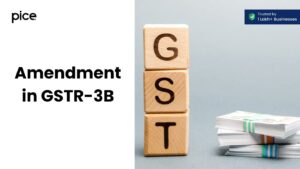How to File Revised Return in GST?
- 26 Nov 24
- 10 mins

How to File Revised Return in GST?
Key Takeaways
- Revised GST returns aim to simplify compliance by allowing error amendments from April 2025.
- GST returns, like GSTR-1 and GSTR-3B, must be filed based on business type and turnover frequency.
- Minor errors in GST returns can be rectified within specific timelines under the new system.
- The proposed Section 139(5) enables filing revised returns for correcting unintentional errors.
- Streamline GST payments and compliance effortlessly with the PICE App.
The structure of Goods and Services Tax (GST) has been evolving since its implementation in 2017. One of the primary areas of its compliance requirements is the accurate and timely filing of GST returns. As per recent discussions, a revised system of GST returns may be implemented by April 2025.
The new change is expected to provide benefits to taxpayers by simplifying the return filing procedure and granting the ability for businesses to make changes in auto-populated returns. In this blog, we will discuss how to file a revised return in GST and what to expect from the revised GST returns.
What Is the GST Return?

Goods and Services Tax return is a vital document which contains the details of your purchases, sales, tax collection on sales (output tax), and input taxes which is the tax payment on purchases. Upon filing the GST return form, you must pay the money you are liable to pay to the Government, i.e., tax liability.
All dealers and business owners who have GST registration need to file GST returns as per their business transaction type.
What Is the Frequency of Filing GST Returns?
A GST-registered person can file GST returns either monthly or quarterly. He is eligible to change the frequency of filing returns from quarterly to monthly, and vice versa. Businesses with an aggregate turnover of ₹5 crore in the previous financial year are eligible to file GST returns on a monthly or quarterly basis.
On the other hand, businesses with an aggregate turnover above ₹5 crore in the previous financial year are eligible to file returns every month.
Types of GST Returns
Following are the various types of GST returns:
- GSTR-1:
GSTR-1 consists of the outward supply details or details of all goods and services along with their sale transactions during the tax period. Precisely, it consists of all the invoices and debit notes that you issue on the sales transactions throughout the tax period.
In case of monthly return filing, you must file GSTR-1 on or prior to the 11th of the following tax year. In the case of quarterly filing, you need to file the return prior to the 13th of the following month, which follows the quarter end.
- GSTR-3B:
It is a monthly return that contains details of tax collection on outward supplies and tax payment details on input supplies. It is mandatory to file the return even in the absence of any business activity. In that case, you need to file the Nil return. The due date for filing GSTR 3B is the 20th of the month, which follows the tax period.
- GSTR-4:
All composition dealers or composite taxpayers need to file GSTR-4. You need to file this return annually on the 30th of April which follows the specific financial year.
- GST CMP-08:
GST CM-08 is a quarterly self-assessed statement-cum-payment which every composition taxpayer needs to file. The due date for filing CMP-08 is the 18th of the month succeeding the quarter.
- GSTR-5:
Non-resident taxpayers or non-resident businesses need to file GSTR-5. It contains details of business for non-residents, including the details of purchases and sales. You need to file this return 20th of every month.
- GSTR-5A:
GSTR-5A is a summary of returns which furnishes the outward taxable supplies and the tax which is payable by the OIDAI (Online Information and Database Access or Retrieval Services) provider under the Goods and Services Tax regime. You need to file this return on the 20th of each month.
- GSTR-6:
It contains details of the ITC (Input Tax Credit) that you have received and the ITC that the Input Service Distributor distributed. The Input Service Distributor files this return on the 13th of each month.
- GSTR-7:
A taxpayer files GSTR-7 on a monthly basis for deducting TDS (Tax Deducted at Source) under the Goods and Services Tax regime. This return furnishes details of taxes deducted, liabilities and refund of taxes. You need to file GSTR-7 by the 10th of next month.
- GSTR-8:
E-commerce operators who need to collect TCS (Tax Collected at Source) and have GST registration need to file GSTR-8 monthly. This return furnishes the details of supplies by e-commerce platforms and tax collection on these transactions. You need to file GSTR-8 on the 10th of the next month.
- GSTR-9:
A GST-registered dealer files GSTR 9, the yearly return or annual return form on 31st December every year. It contains all inward and outward sales details along with details of inward purchases during the particular financial year. You need to file this return on an annual basis.
- GSTR-9C:
Every taxpayer with an annual turnover of more than ₹5 crore in a tax period needs to file this reconciliation statement. As per the guidelines, a Cost/Management Accountant or a Chartered Accountant needs to certify this return after auditing the books of accounts.
He also needs to compare the figures of GSTR-9C with those of GSTR-9. The due date for filing this return is 31st December of a year, which follows the subsequent accounting year.
- GSTR-10:
A taxpayer needs to file GSTR-10 in cases of cancellation of taxpayer registration. This return is required to be filed within 3 months of cancellation of the registration.
- GSTR-11:
The Form GSTR-11 needs to be filed by every registered taxpayer who has been issued a Unique Identity Number (UIN) to get a refund under GST for the purchased goods and services in India. There is no due date for GSTR-11 filing. All UIN holders can file GSTR-11 at any specific time, following the end of a quarter.
Can GST returns be amended or corrected?

Once a GST return is filed, amendment or correction is not possible. As per the new system of return filing, you can amend minute errors while uploading the details to the sales invoice in the following months of return.
Which GST Returns Can Be Amended Or Corrected?
Here are some of the returns which are subject to amendments or rectification:
- You are eligible to amend the errors in Form GSTR-1 and GSTR-3B. These errors include output tax liability, credit, etc. You can, however, make the amendments within a specific time limit.
- Although you can not make amendments directly in GSTR-9, the changes that you make in GSTR-1 and GSTR-3B will also be reflected in the annual return.
What Amendments or Corrections Can Be Made in GST Returns?
Following are some of the minor corrections or amendments that you can make in pre-filled returns:
- You can amend the human errors relating to the tax rate, taxable amount, etc., in Form GSTR-1. You can incorporate these corrections by filing for amendments to revised invoice details in the GSTR-1 of the following month. However, in case of mistakes in the party name, SGST, CGST, or IGST, GSTIN, etc., you cannot make any amendments.
- According to Section 37(3) of the Central Goods and Services Tax (CGST) Act, a taxpayer can rectify the details furnished under Section 37(1) that have been mismatched under Section 42 or 43 of the CGST Act. They are also eligible for tax and interest payments. In cases of short tax payment computation, the taxpayer needs to furnish the return for the tax period to validate the calculation error or omission.
- While making adjustments in input tax credit reporting or output tax liability, it is important to note that no negative entries can be there in Form GSTR-3B. If you leave any amount for adjustment, you can adjust in Form GSTR-3B in the following months. You can also claim a refund to avoid such adjustments.
How to File Revised GST Return Under Section 139(5)?
Follow the steps below to file a revised GST return u/s 139(5):
- Create your account or sign in to the official portal with valid credentials.
- You will see a table that consists of every source of taxable income. Proceed to select all your sources of income.
- Upload Form 16, if you have it. If you do not, skip this particular option.
- Select the specific financial year and mention your date of birth and PAN details.
- Enter the necessary details, like name, father’s name, email ID, gender, etc., if not auto-filled by the Income Tax Department.
- Provide the details of your address in the following step, along with the employer category.
- Fill up the details of your employment. In the case of salaried employees, they will automatically apply the standard deduction.
- Enter investment details for applicable deduction calculation. You also need to enter details of your investments in LIC, PPF, housing loans, tuition fees, etc.
- Enter your bank account details and upload Form 26AS.
- Select the option ‘Revised Return’ under the category of return filing type and mention the original return’s acknowledgement number.
- The software will automatically calculate your tax liability.
- Upon verification of the information, tick the checkbox and tap on ‘File My Return.’
Conclusion
To simplify robust GST compliance and the current fiscal landscape, the option to rectify unintentional errors through revised returns is being considered. Once approved by the law committee and GST Council, it will make filing corrections easier.
Thus, understanding how to file a revised return in GST will become crucial for registered businesses.
💡If you want to streamline your payment and make GST payments, consider using the PICE App. Explore the PICE App today and take your business to new heights



















